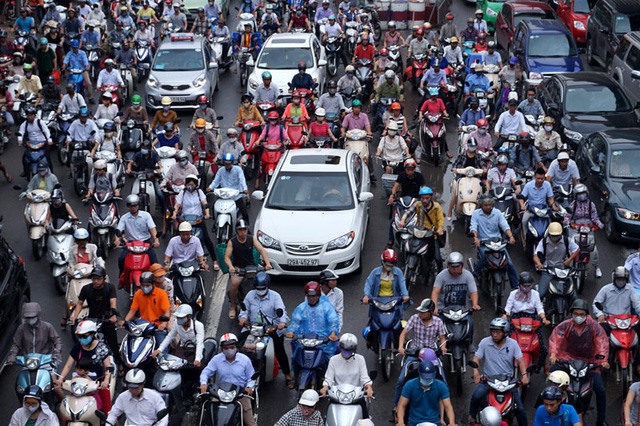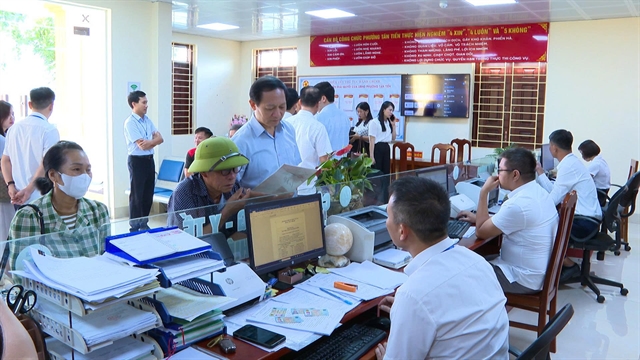.jpeg) Society
Society
.jpeg)
Although Hà Nội is one of the country’s biggest cities, its system for removing broken-down vehicles from crowded roads is ineffective, traffic users and experts say.
 |
| Although Hà Nội is one of the country’s biggest cities, its system for removing broken-down vehicles from crowded roads is ineffective, traffic users and experts say. — Photo giadinh.net |
HÀ NỘI – Although Hà Nội is one of the country’s biggest cities, its system for removing broken-down vehicles from crowded roads is ineffective, traffic users and experts say.
Traffic rescue sometimes takes a long time due to unprofessional and inadequate technical operations, resulting in traffic jams and inconvenience for road users, said Đỗ Trọng Tuấn, deputy head of Hà Nội Police’s Traffic Police Team No 14.
“The situation of cars overturning or ‘lying’ on the Thanh Trì Bridge due to a broken engine, causing traffic jams for many hours after traffic accidents occurs so often,” he told the Kinh Tế va đô thị (Economic and Urban Affairs) newspaper.
Tuấn pointed out the city lacks adequate equipment to recover trucks with large loading capacity, worsening the traffic problems after a work.
The problem is reported throughout the city.
“With many other road users who suffered in the hot weather in rush hour in Láng Hạ Street one day, I was stuck on the road for hour,” said Phương Lan, a resident of Đống Đa District. “The reason turned out that a car broken on the road was blocking traffic. The car owner phoned many vehicle rescuing services several times but she was asked to wait because there were no recovery vehicles available at the moment,” she said.
Major Vũ Văn Hoài, head of Hà Nội Police’s Traffic Safety Dissemination, said traffic police divisions can handle only motorbikes and small vehicles. For trucks with capacity of over 10 tonnes, they have to hire recovery service from private enterprises.
The traffic police bear a range of responsibilities in the aftermath of a crash. In cases of fire and explosion, the traffic police must inform road users through the mass media as well as asked traffic officials to regulate the traffic.
The emergency staff 115 is in charge of the first aid work for victims of traffic accidents. But many cases of traffic accidents occur in narrow city roads or at peak hours. Emergency forces are still likely to come late, so the traffic police must co-ordinate with them to rescue the victims.
Therefore, the vehicle recovery personnel must have basic knowledge of automotive issues and first aid in order to handle all possible rescue situations, Hoài said, adding that sometimes the recovery service does not meet expectations.
In recent years, the traffic pressure in Hà Nội has increased and so have traffic accidents.
Statistics from the City’s Traffic Safety Committee showed that there were 1,045 traffic accidents in the first nine months of this year, killing 414 and injuring 828.
Most of traffic accidents related to passenger and goods transportation services.
It is time for the city authorities to set up a professional traffic rescue centre or a specialised force for this task, said Đặng Chí Nga, a traffic expert.
He suggested that city authority assign the traffic police force to build a professional rescue centre with a network covering the entire city. Otherwise, local authorities may be required to set up mobile rescue teams.
Specially, Nga said, the city should consider buying equipment to recover large-capacity vehicles and employing staff with professional training.
The charge of the service was also matter of concern for users, experts said. Currently, the fee for recovery service is paid by the vehicle owners.
If the city has a rescue centre with professional forces and adequate equipment, Nga said, it can ensure people are not overcharged by private enterprises.
Most importantly, the traffic police can take the initiative in dispatching personnel to the site to rescue the victims of traffic accidents, minimising the duration of traffic jams.
Vũ Thị Trang, a resident from Cầu Giấy District, agreed that the vehicle recovery service needs significant improvement.
“I had a terrible night three months ago. My car broke down while I was driving on Trần Thái Tông Street. I was terribly frightened. Because I – a woman – was alone in the late night,” she said. “I could not contact any public vehicle rescuing services at that moment. So after calling hundreds of phone calls I found a private vehicle rescuing service with high charge. But in that time I did not have any choice but paying.”
“I wondered why the traffic police did not have the 24-hour service?” she said. — VNS
.jpeg)



